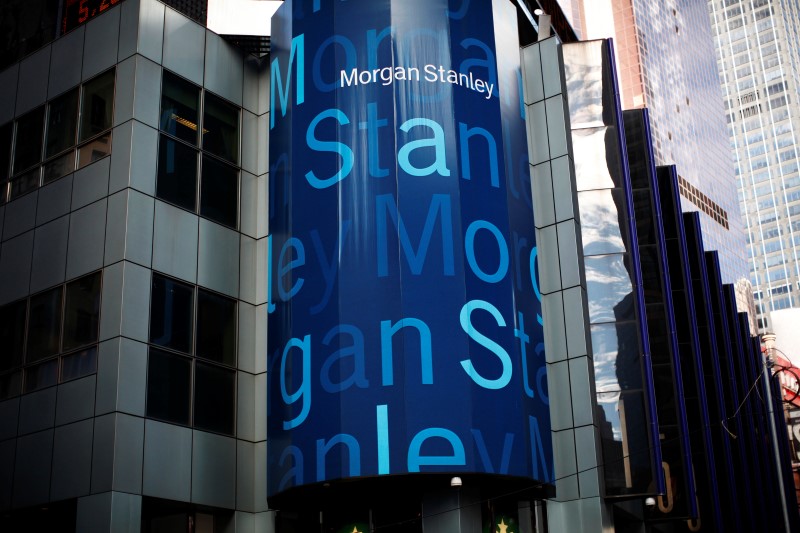By Olivia Oran
(Reuters) - When a founder of a tech startup wants to buy a home but has all his money parked in illiquid stock, or a pro-athlete wants to buy a Porsche but has not yet received his guaranteed payout, Morgan Stanley (NYSE:MS) wants to be the lender they turn to.
In fact, the bank wants to double the size of these custom loans to 10 percent of its loan book, up from about 5 percent today, Eric Heaton, president of Morgan Stanley's U.S. banks, told Reuters in an interview.
The idea is to strengthen ties with wealthy individuals so they will be more inclined to use Morgan Stanley for other services - whether that is managing their investments, selling a business or taking one public.
Morgan Stanley has been lending more since acquiring the Smith Barney brokerage business from Citigroup Inc (NYSE:C). It had almost $200 billion worth of loans at year-end – quadruple its size three years earlier.
Until recently, Morgan Stanley has not focused much on what it calls "tailored lending" because it's a niche business: only 20,000 of the bank's more than 3 million clients qualify for such loans, by having a minimum of $10 million in investable assets.
Morgan Stanley first focused on the simpler, less lucrative business of lending against wealth clients' investment portfolios, as well as mortgages and merger financing. It is now turning to tailored loans because they have high profit margins and, perhaps more importantly, because it's a good way to encourage wealthy clients to do more business with Morgan Stanley.
"This isn't a one-off initiative to grow the bank, it's an important piece," said Heaton.
Though he declined to give a timeframe for reaching the 10 percent target, Morgan Stanley has been laying the groundwork for some time.
In 2014, it hired Marcus Mitchell from Deutsche Bank AG (DE:DBKGn) to oversee its tailored lending build-out. A year ago, the bank started making loans with museum-quality art as collateral. More recently it began lending against stock in privately held companies, and is now looking toward other offerings, including loans against private aircraft.
Tailored lending is just one component of Morgan Stanley's broader lending goals. Management has set its focus on loans as a key source of revenue growth, as the bank struggles to generate a return on shareholder capital of 9 to 11 percent by 2017. That goal, set by Chief Executive James Gorman, has been elusive because of hard luck in other businesses – particularly fixed-income trading.
Morgan Stanley is not the only bank facing these challenges. Although most rivals have been producing better returns, near-zero interest rates have broadly weighed on profits, because they diminish the money banks can earn investing idle cash in securities.
That means competition to lend to the most attractive borrowers is stiff. And when it comes to tailored lending, risks can be hard to manage, said Portales Partners analyst Paul Gulberg.
"This type of lending carries idiosyncratic risk," he said. "Your risk is against mispricing something because you are working with products that are very unique."
HIGH MARGINS
Morgan Stanley says it hires outside appraisers to assess values of one-of-a-kind items it lends against. The bank believes tailored loans are worth the risk, partly because they tend to have higher margins than traditional loans like mortgages, Mitchell said in an interview.
Mitchell would not say what margins Morgan Stanley earns on tailored loans, but because clients often need financing in a pinch, and because the loans have unique risk profiles, banks have more leeway in charging higher rates.
A private banking executive at another firm said that very unusual tailored loans can deliver margins of eight percentage points but that the types of loans Morgan Stanley is offering likely have much lower margins. By comparison, mortgages tend to have a margin of around 1 percentage point, analysts said.
Morgan Stanley currently lends out about $50 billion of its $149 billion in deposits within wealth management, and is targeting $60 billion by the end of 2017. Tailored loans account for roughly $4.5 billion of that, compared with $21 billion in mortgages.
Morgan Stanley is also looking to expand into other types of lending. For instance, late last year it began extending loans to private-equity funds that need cash for investments between the time investors commit capital and deliver hard cash.

These so-called "capital call subscriptions" come with a special risk too: that investors may not send the money they promised. Heaton said the risks are low and the business is profitable.